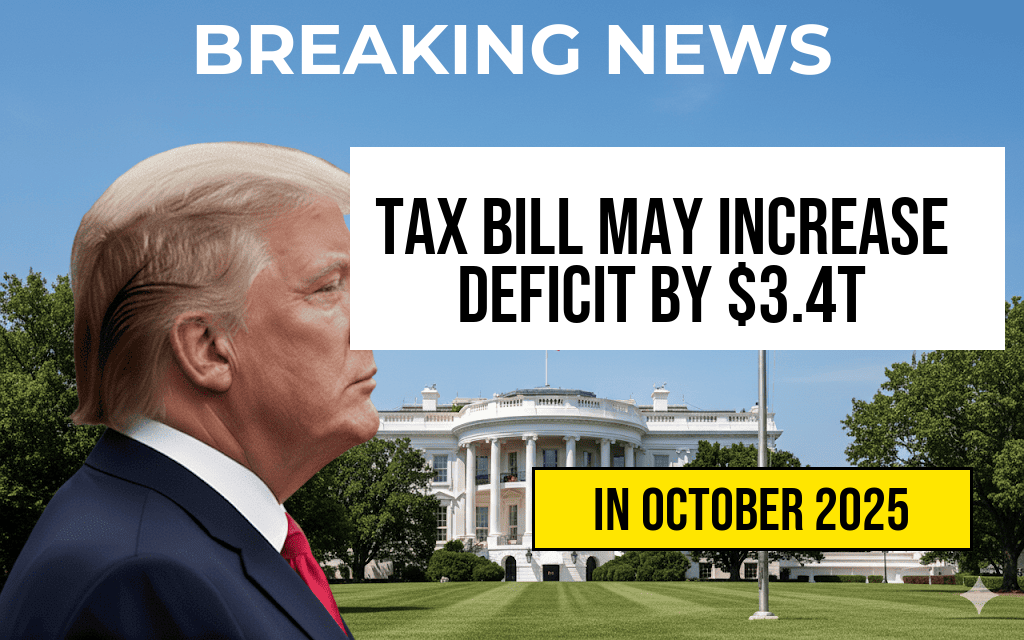Amid ongoing debates over federal fiscal policy, a new legislative proposal known as the “One Big Beautiful Bill” has garnered significant attention for its potential to dramatically alter the nation’s fiscal outlook. Experts warn that if enacted, the bill could lead to an unprecedented increase in the federal deficit by approximately $3.4 trillion, raising concerns about long-term economic stability and fiscal responsibility. While proponents argue that the bill could stimulate economic growth through targeted spending and tax incentives, critics contend that its expansive scope and lack of offsetting revenue measures may exacerbate national debt levels to heights not seen in recent history.
What is the ‘One Big Beautiful Bill’?
The One Big Beautiful Bill is a comprehensive legislative package aimed at overhauling multiple sectors, including infrastructure, healthcare, and social programs. Introduced by a coalition of lawmakers seeking to inject substantial federal funds into economic development initiatives, the bill proposes a sweeping increase in federal spending—estimated to be upwards of $4 trillion over ten years. Despite its ambitious goals, the bill’s financing structure remains a focal point of controversy, particularly regarding how it plans to manage the resulting deficit surge.
Projected Fiscal Impact and Concerns
According to recent analyses by independent budget experts, the bill’s current provisions could inflate the federal deficit by approximately $3.4 trillion over a decade. This projection is based on the assumption that the bill’s spending initiatives will not be fully offset by new revenue streams or spending cuts elsewhere in the federal budget.
| Component | Estimated Cost (Over 10 Years) |
|---|---|
| Infrastructure Investment | $1.5 trillion |
| Healthcare Expansion | $1 trillion |
| Tax Incentives and Credits | $0.8 trillion |
| Other Social Programs | $0.7 trillion |
| Subtotal | $4 trillion |
| Estimated Increase in Deficit | $3.4 trillion |
Sources of Funding and Legislative Challenges
Supporters of the bill emphasize its potential to jumpstart economic growth, arguing that increased public investment could lead to higher GDP and job creation that, over time, would offset initial deficits. However, critics highlight the absence of concrete revenue measures, such as new taxes or closing loopholes, to counterbalance the spending. The bill’s financing relies heavily on future economic gains and borrowing, raising alarms about the sustainability of such debt levels.
- Tax Policies: Proposed tax cuts for corporations and high-income earners may reduce revenue intake.
- Borrowing: The bill could increase reliance on debt issuance, adding to the national debt burden.
- Economic Assumptions: Optimistic forecasts about growth may not materialize as expected, risking larger deficits.
Political and Economic Reactions
Reactions to the One Big Beautiful Bill have been sharply divided along partisan lines. Democratic supporters argue that the legislation addresses critical infrastructure needs and social inequities, asserting that investment now will lead to long-term fiscal benefits. Conversely, Republican opponents warn that the bill’s expansive spending and lack of sufficient revenue sources threaten future economic stability and burden future generations with unsustainable debt.
Expert Opinions
Economists warn that an increase of this magnitude could lead to higher interest rates and inflation if not carefully managed. Dr. Laura Stevens, an economist at the Harvard Kennedy School, emphasized that reliance on borrowing without clear revenue measures could impair the government’s creditworthiness. Meanwhile, fiscal watchdog groups have called for more transparency and fiscal responsibility before moving forward with such a costly legislative effort.
Implications for the Future
The potential $3.4 trillion deficit increase underscores the delicate balance policymakers face when pursuing economic expansion versus fiscal sustainability. If the bill proceeds without adjustments, it could accelerate existing debt trajectories, potentially leading to higher borrowing costs and reduced fiscal flexibility. As debates continue, the question remains whether the bill’s envisioned economic benefits can realistically offset its substantial fiscal costs.
For more information on federal budget projections and economic policy, visit Wikipedia’s Federal Budget article and [Forbes’ coverage on fiscal policy](https://www.forbes.com/).
Frequently Asked Questions
What is the main concern raised in the article about the “One Big Beautiful Bill”?
The article warns that the “One Big Beautiful Bill” could potentially increase the federal deficit by approximately three point four trillion dollars, raising concerns about its long-term fiscal impact.
How might the bill impact the national budget deficit?
According to the analysis, the bill could significantly increase the budget deficit by adding substantial costs, which may lead to increased borrowing and potential economic consequences.
What are the potential economic implications of the bill’s passage?
The article suggests that a substantial increase in the deficit could result in higher interest rates, reduced public investments, and increased financial strain on future generations.
Who are the main stakeholders affected by this bill?
The bill impacts taxpayers, government finances, and public services. It also concerns policymakers, economists, and fiscal watchdogs monitoring the nation’s economic stability.
What actions are recommended to address the potential deficit increase?
The article recommends careful scrutiny of the bill’s provisions, considering fiscal responsibility, and exploring alternative measures to achieve policy goals without significantly increasing the debt.

Leave a Reply